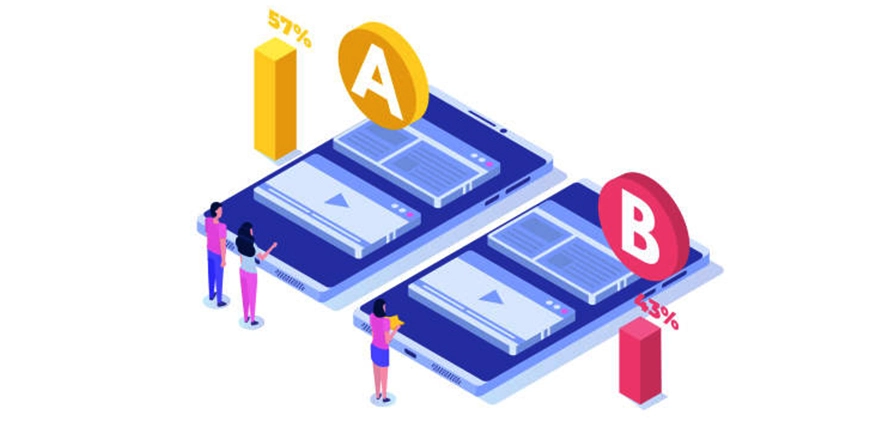Table of Contents
Ultimate Guide to A/B Testing in SEO: Improve Rankings and Traffic
A/B testing SEO compares two iterations of a webpage to see which one performs better. This process helps in understanding how different changes can impact your website’s ranking and organic traffic. It involves dividing your traffic into two groups: one experiences the original version (A), and the other experiences the modified version (B).
Understanding A/B Testing in SEO

What is A/B Testing in SEO?
A/B testing in SEO involves comparision of two versions of a webpage that determines which one perform is better in terms of search engine optimization. This process helps in understanding how different changes can impact your website’s ranking and organic traffic. It involves dividing your traffic into two groups: one experiences the original version (A), and the other experiences the modified version (B).
Importance of A/B Testing for SEO
A/B testing is essential for SEO as it provides concrete data on how specific changes affect search engine rankings. This approach allows businesses to optimize their web pages scientifically, leading to improved visibility, higher click-through rates, and ultimately more conversions.
Historical Background of A/B Testing in SEO
The concept of A/B testing originated from the scientific method and statistical analysis. Its application in SEO became prominent as businesses recognized the need for data-driven decisions to enhance their online presence. Over the years, advancements in technology have made the testing services more accessible and integral to SEO strategies.
The A/B Testing Process for SEO
Setting SEO Objectives

The first step in A/B testing for SEO is defining clear and measurable objectives. These objectives could range from increasing organic traffic and improving page rankings to reducing bounce rates and enhancing user engagement.
Choosing SEO Variables
Identify the elements of your webpage that you want to test. Primary SEO variables could include meta titles, meta descriptions, header tags, and content structure. Secondary variables might be internal links, image alt texts, and URL structures.
Formulate hypotheses based on your objectives and chosen variables. For instance, “Adding relevant keywords to the meta description will increase the click-through rate by 15%.”
Designing the SEO Experiment
In an SEO A/B test, the control group experiences the original webpage, while the variation group sees the modified version. Ensure these groups are randomly selected and representative of your audience to maintain the validity of the test.
Running the SEO Test
Decide on the duration for your SEO test. It should be long enough to gather sufficient data but not too long to be affected by external factors. Timing is crucial; avoid periods with unusual traffic patterns, such as holidays or major events.
Analyzing SEO Results
After concluding the test, analyze the data to determine if the observed differences are statistically significant. This means the results are unlikely due to chance and indicate a real impact on SEO performance.
Based on the analysis, implement the winning variation. Continuously monitor its performance to ensure the changes positively impact your SEO objectives over time.
Tools and Software for A/B Testing in SEO

Popular SEO A/B Testing Tools
Google Optimize integrates well with Google Analytics, offering robust features for running SEO A/B tests, including multivariate and redirect tests.
Optimizely provides advanced features for A/B testing, including behavioral targeting and real-time data analysis, making it a strong choice for SEO search optimization.
VWO offers a comprehensive suite for A/B testing, heatmaps, session recordings, and user feedback, known for its user-friendly interface and detailed reporting capabilities.
Comparing Features and Pricing of SEO Tools
When choosing an SEO A/B testing tool, consider your budget and specific feature needs. Google Optimize is great for beginners due to its free plan, while Optimizely and VWO offer more advanced features for larger enterprises.
Best Practices for A/B Testing in SEO

Ensuring SEO Test Validity
To ensure your SEO A/B test is valid, randomize the assignment of users to control and variation groups. Ensure the sample size is large enough to detect meaningful differences and avoid making multiple changes at once.
Avoiding Common SEO Pitfalls
A typical error is to use a sample size that is too small. Small samples can lead to inconclusive results and misinterpretations.
Testing too many variables simultaneously can complicate the analysis. Focus on one or two key variables to isolate their effects accurately.
Interpreting SEO Data Correctly
Data from SEO A/B tests can be complex. Ensure you have the skills to interpret it correctly or consult with a data analyst. Decisions and conclusions drawn from data interpretation errors might be disastrous.
Real-World Examples of A/B Testing in SEO

Successful SEO Case Studies
Myntra, an e-commerce giant, used SEO A/B testing to optimize their product pages. By tweaking meta descriptions and adding schema markup, they saw a 20% increase in organic traffic.
Company D, a SaaS provider, tested different blog title formats. The winning variation, which included more long-tail keywords, resulted in a 15% increase in search engine visibility.
Lessons Learned from SEO Testing Failures
Not all SEO A/B tests yield positive results. Sometimes, changes can negatively impact performance. It’s essential to learn from these failures, understand what went wrong, and apply those lessons to future tests.
Advanced SEO A/B Testing Techniques
Multivariate Testing in SEO
Multivariate testing in SEO involves testing multiple variables simultaneously to see how they interact. This approach provides deeper insights but requires more sophisticated analysis.
Sequential Testing in SEO
Sequential testing involves analyzing data as it is collected and stopping the test once sufficient evidence is gathered. This method can save time and resources but requires careful statistical handling.
Frequently Asked Question
What is the minimum sample size for SEO A/B testing?
The minimum sample size for SEO A/B testing depends on the expected effect size and desired statistical significance. However, a common rule of thumb is to have at least a few thousand users in each group to ensure reliable results.
How long should an SEO A/B test run?
An SEO A/B test should run for at least 2-4 weeks to account for variability in traffic and behavior patterns. However, the duration may vary depending on the traffic volume and the specific objectives of the test.
Can A/B testing be used for mobile SEO?
Yes, A/B testing can and should be used for mobile SEO. Testing mobile-specific elements such as responsive design, mobile-friendly content, and load times can significantly impact your mobile search rankings and user experience.
What are the risks of SEO A/B testing?
Risks of SEO A/B testing include potential negative impacts on search rankings if changes are not well-received by users or search engines. There is also the risk of inconclusive results if the sample size is too small or the test duration is too short.
How to start with SEO A/B testing for a small business?
To start with SEO A/B testing for a small business, begin with simple tests on key elements such as titles, meta descriptions, and content structure. Use free or affordable tools like Google Optimize and focus on one or two variables at a time to ensure clear and actionable results.







